Murdoch University MBS684: Strategic Risk Management for Woolworths
VerifiedAdded on 2023/06/09
|12
|3882
|221
Report
AI Summary
This report delves into the strategic risk management practices of Woolworths, a major Australian retail group. It begins with an executive summary outlining the company's three-tiered risk management structure, involving business-level controls, an executive committee, and the Board of Directors. The report identifies key risk categories, including preventable risks, strategy risks, and external risks, and provides a scoping report that summarizes strategic, financial, operational, and compliance risks faced by Woolworths. It discusses the roles of external and internal auditors, along with management assurances and shareholder engagement. The report connects theoretical concepts of risk management with practical examples specific to Woolworths, such as the competitive retail environment and the impact of market changes. It analyzes the importance of understanding different risk types and implementing mitigation strategies. The report includes a detailed analysis of the role of a strategic risk consultant and offers recommendations based on the identified risks. The report also examines how Woolworths handles external and internal audits to ensure the effectiveness of its risk management framework. It then discusses the importance of continuous disclosure of information to maintain transparency and investor confidence. The report then provides recommendations for risk management practices and concludes by summarizing key findings and implications for Woolworths.
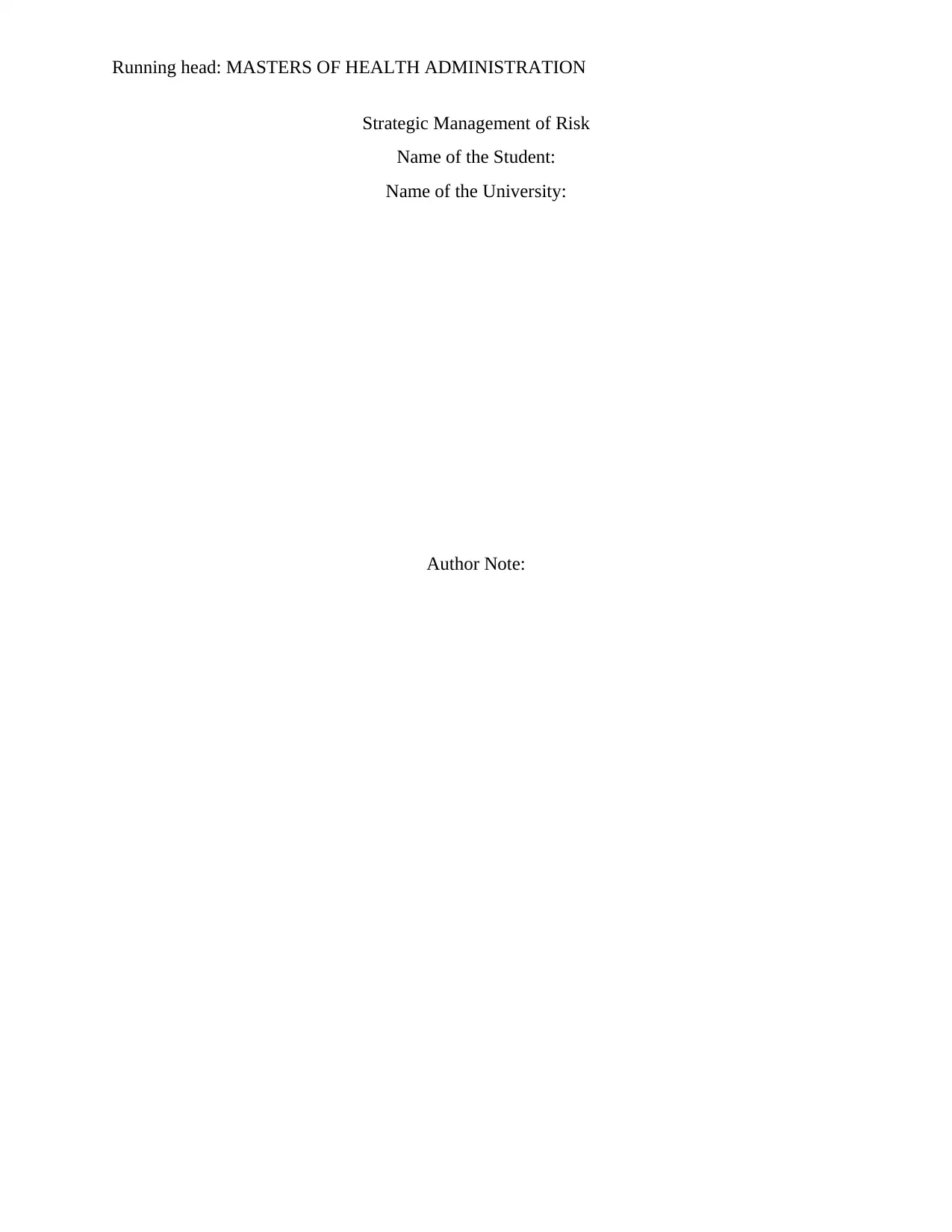
Running head: MASTERS OF HEALTH ADMINISTRATION
Strategic Management of Risk
Name of the Student:
Name of the University:
Author Note:
Strategic Management of Risk
Name of the Student:
Name of the University:
Author Note:
Paraphrase This Document
Need a fresh take? Get an instant paraphrase of this document with our AI Paraphraser
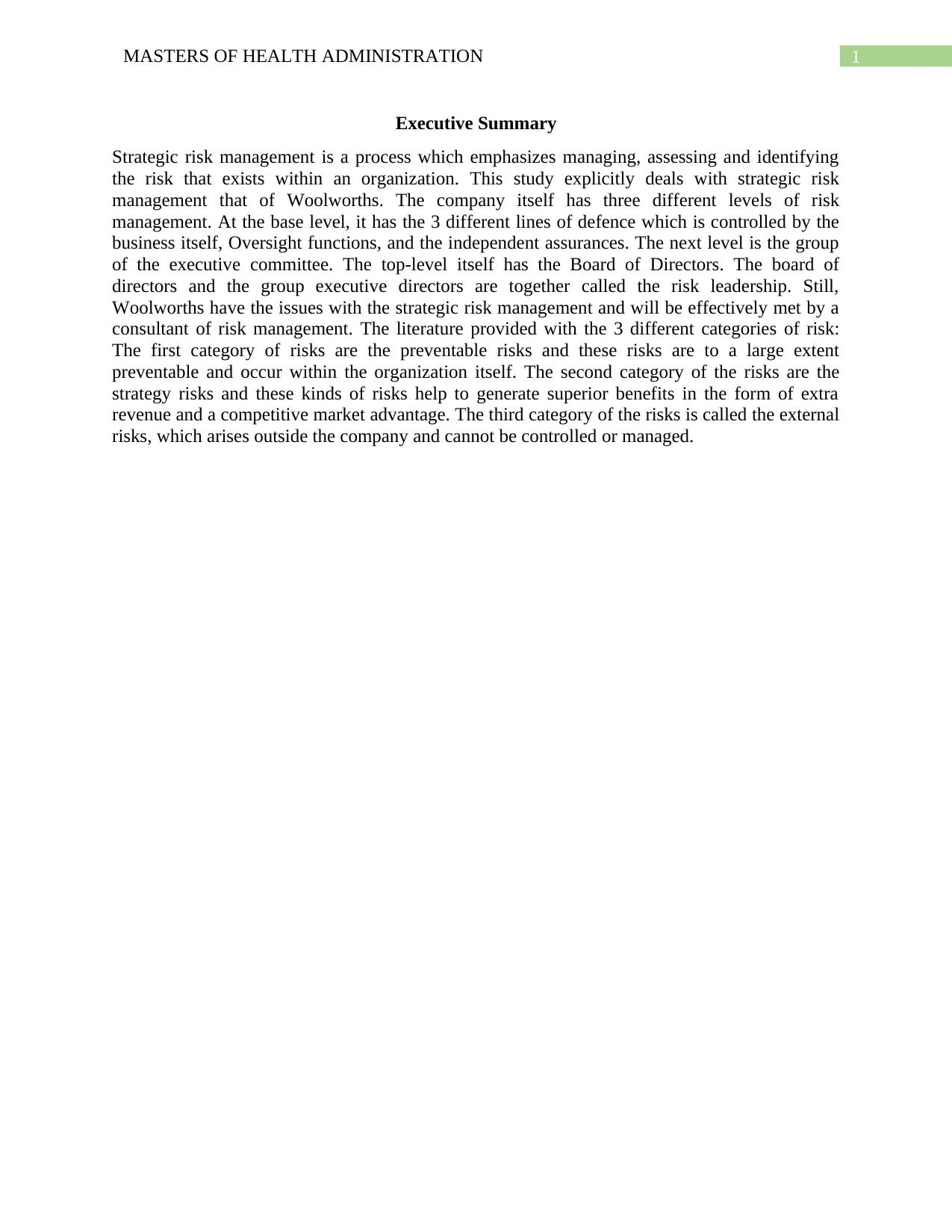
1MASTERS OF HEALTH ADMINISTRATION
Executive Summary
Strategic risk management is a process which emphasizes managing, assessing and identifying
the risk that exists within an organization. This study explicitly deals with strategic risk
management that of Woolworths. The company itself has three different levels of risk
management. At the base level, it has the 3 different lines of defence which is controlled by the
business itself, Oversight functions, and the independent assurances. The next level is the group
of the executive committee. The top-level itself has the Board of Directors. The board of
directors and the group executive directors are together called the risk leadership. Still,
Woolworths have the issues with the strategic risk management and will be effectively met by a
consultant of risk management. The literature provided with the 3 different categories of risk:
The first category of risks are the preventable risks and these risks are to a large extent
preventable and occur within the organization itself. The second category of the risks are the
strategy risks and these kinds of risks help to generate superior benefits in the form of extra
revenue and a competitive market advantage. The third category of the risks is called the external
risks, which arises outside the company and cannot be controlled or managed.
Executive Summary
Strategic risk management is a process which emphasizes managing, assessing and identifying
the risk that exists within an organization. This study explicitly deals with strategic risk
management that of Woolworths. The company itself has three different levels of risk
management. At the base level, it has the 3 different lines of defence which is controlled by the
business itself, Oversight functions, and the independent assurances. The next level is the group
of the executive committee. The top-level itself has the Board of Directors. The board of
directors and the group executive directors are together called the risk leadership. Still,
Woolworths have the issues with the strategic risk management and will be effectively met by a
consultant of risk management. The literature provided with the 3 different categories of risk:
The first category of risks are the preventable risks and these risks are to a large extent
preventable and occur within the organization itself. The second category of the risks are the
strategy risks and these kinds of risks help to generate superior benefits in the form of extra
revenue and a competitive market advantage. The third category of the risks is called the external
risks, which arises outside the company and cannot be controlled or managed.
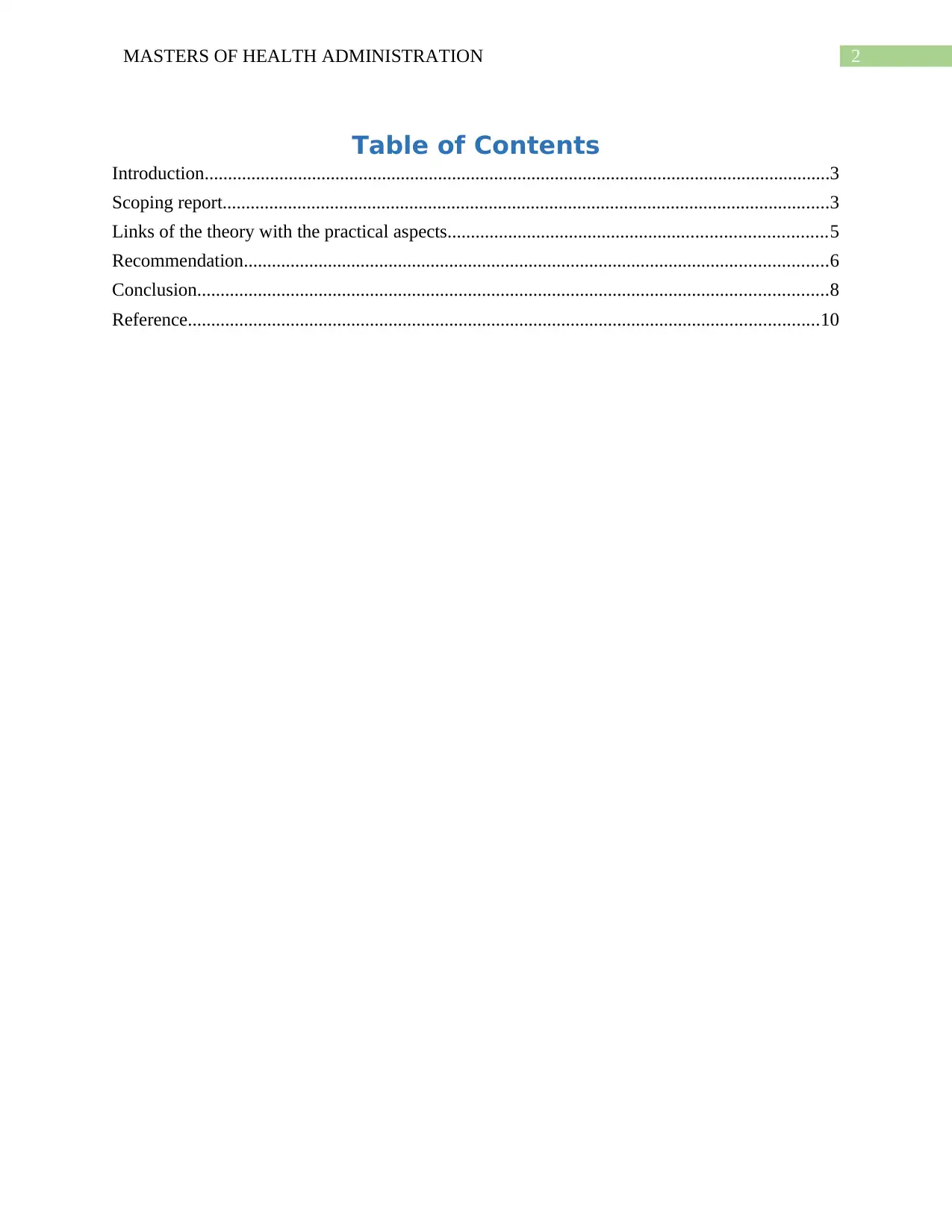
2MASTERS OF HEALTH ADMINISTRATION
Table of Contents
Introduction......................................................................................................................................3
Scoping report..................................................................................................................................3
Links of the theory with the practical aspects.................................................................................5
Recommendation.............................................................................................................................6
Conclusion.......................................................................................................................................8
Reference.......................................................................................................................................10
Table of Contents
Introduction......................................................................................................................................3
Scoping report..................................................................................................................................3
Links of the theory with the practical aspects.................................................................................5
Recommendation.............................................................................................................................6
Conclusion.......................................................................................................................................8
Reference.......................................................................................................................................10
⊘ This is a preview!⊘
Do you want full access?
Subscribe today to unlock all pages.

Trusted by 1+ million students worldwide
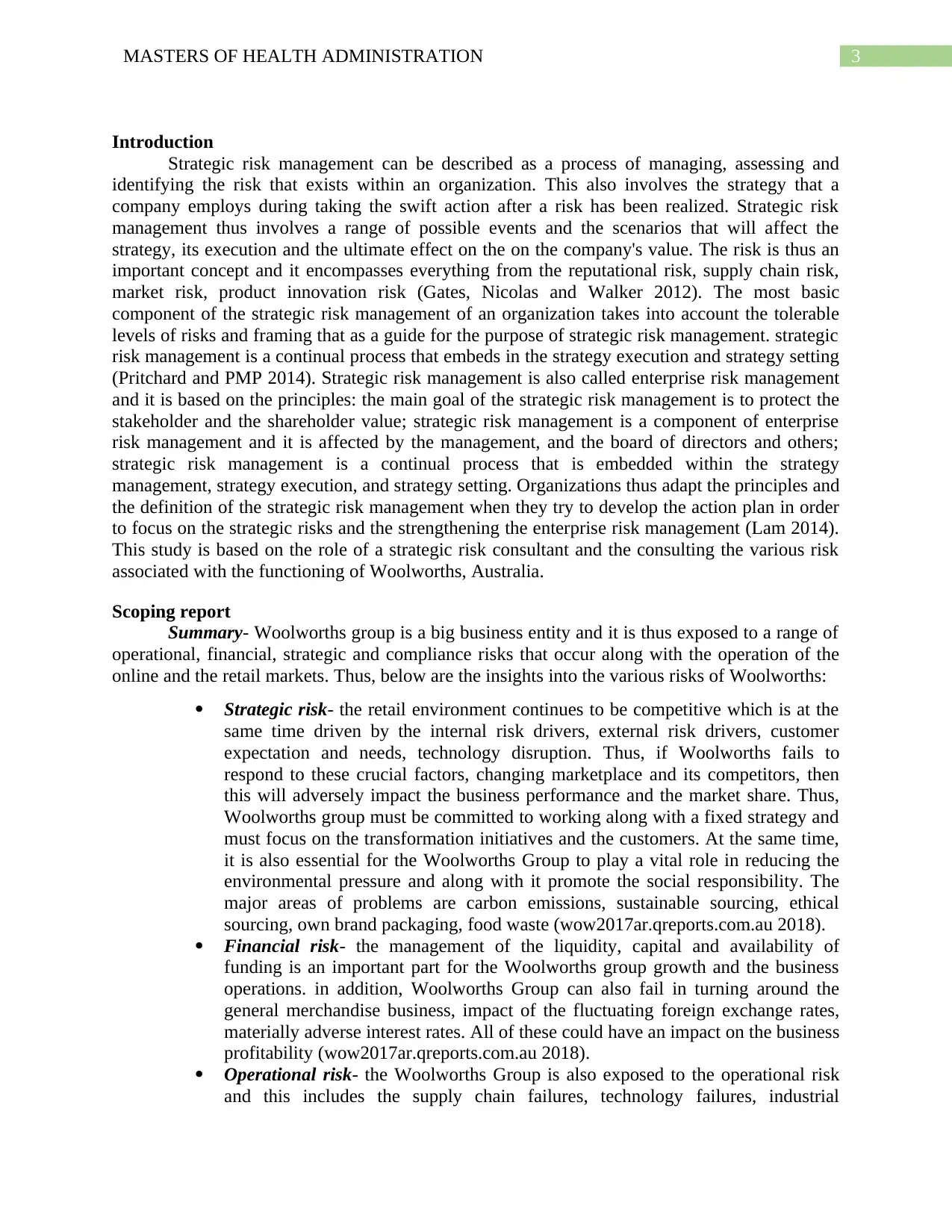
3MASTERS OF HEALTH ADMINISTRATION
Introduction
Strategic risk management can be described as a process of managing, assessing and
identifying the risk that exists within an organization. This also involves the strategy that a
company employs during taking the swift action after a risk has been realized. Strategic risk
management thus involves a range of possible events and the scenarios that will affect the
strategy, its execution and the ultimate effect on the on the company's value. The risk is thus an
important concept and it encompasses everything from the reputational risk, supply chain risk,
market risk, product innovation risk (Gates, Nicolas and Walker 2012). The most basic
component of the strategic risk management of an organization takes into account the tolerable
levels of risks and framing that as a guide for the purpose of strategic risk management. strategic
risk management is a continual process that embeds in the strategy execution and strategy setting
(Pritchard and PMP 2014). Strategic risk management is also called enterprise risk management
and it is based on the principles: the main goal of the strategic risk management is to protect the
stakeholder and the shareholder value; strategic risk management is a component of enterprise
risk management and it is affected by the management, and the board of directors and others;
strategic risk management is a continual process that is embedded within the strategy
management, strategy execution, and strategy setting. Organizations thus adapt the principles and
the definition of the strategic risk management when they try to develop the action plan in order
to focus on the strategic risks and the strengthening the enterprise risk management (Lam 2014).
This study is based on the role of a strategic risk consultant and the consulting the various risk
associated with the functioning of Woolworths, Australia.
Scoping report
Summary- Woolworths group is a big business entity and it is thus exposed to a range of
operational, financial, strategic and compliance risks that occur along with the operation of the
online and the retail markets. Thus, below are the insights into the various risks of Woolworths:
Strategic risk- the retail environment continues to be competitive which is at the
same time driven by the internal risk drivers, external risk drivers, customer
expectation and needs, technology disruption. Thus, if Woolworths fails to
respond to these crucial factors, changing marketplace and its competitors, then
this will adversely impact the business performance and the market share. Thus,
Woolworths group must be committed to working along with a fixed strategy and
must focus on the transformation initiatives and the customers. At the same time,
it is also essential for the Woolworths Group to play a vital role in reducing the
environmental pressure and along with it promote the social responsibility. The
major areas of problems are carbon emissions, sustainable sourcing, ethical
sourcing, own brand packaging, food waste (wow2017ar.qreports.com.au 2018).
Financial risk- the management of the liquidity, capital and availability of
funding is an important part for the Woolworths group growth and the business
operations. in addition, Woolworths Group can also fail in turning around the
general merchandise business, impact of the fluctuating foreign exchange rates,
materially adverse interest rates. All of these could have an impact on the business
profitability (wow2017ar.qreports.com.au 2018).
Operational risk- the Woolworths Group is also exposed to the operational risk
and this includes the supply chain failures, technology failures, industrial
Introduction
Strategic risk management can be described as a process of managing, assessing and
identifying the risk that exists within an organization. This also involves the strategy that a
company employs during taking the swift action after a risk has been realized. Strategic risk
management thus involves a range of possible events and the scenarios that will affect the
strategy, its execution and the ultimate effect on the on the company's value. The risk is thus an
important concept and it encompasses everything from the reputational risk, supply chain risk,
market risk, product innovation risk (Gates, Nicolas and Walker 2012). The most basic
component of the strategic risk management of an organization takes into account the tolerable
levels of risks and framing that as a guide for the purpose of strategic risk management. strategic
risk management is a continual process that embeds in the strategy execution and strategy setting
(Pritchard and PMP 2014). Strategic risk management is also called enterprise risk management
and it is based on the principles: the main goal of the strategic risk management is to protect the
stakeholder and the shareholder value; strategic risk management is a component of enterprise
risk management and it is affected by the management, and the board of directors and others;
strategic risk management is a continual process that is embedded within the strategy
management, strategy execution, and strategy setting. Organizations thus adapt the principles and
the definition of the strategic risk management when they try to develop the action plan in order
to focus on the strategic risks and the strengthening the enterprise risk management (Lam 2014).
This study is based on the role of a strategic risk consultant and the consulting the various risk
associated with the functioning of Woolworths, Australia.
Scoping report
Summary- Woolworths group is a big business entity and it is thus exposed to a range of
operational, financial, strategic and compliance risks that occur along with the operation of the
online and the retail markets. Thus, below are the insights into the various risks of Woolworths:
Strategic risk- the retail environment continues to be competitive which is at the
same time driven by the internal risk drivers, external risk drivers, customer
expectation and needs, technology disruption. Thus, if Woolworths fails to
respond to these crucial factors, changing marketplace and its competitors, then
this will adversely impact the business performance and the market share. Thus,
Woolworths group must be committed to working along with a fixed strategy and
must focus on the transformation initiatives and the customers. At the same time,
it is also essential for the Woolworths Group to play a vital role in reducing the
environmental pressure and along with it promote the social responsibility. The
major areas of problems are carbon emissions, sustainable sourcing, ethical
sourcing, own brand packaging, food waste (wow2017ar.qreports.com.au 2018).
Financial risk- the management of the liquidity, capital and availability of
funding is an important part for the Woolworths group growth and the business
operations. in addition, Woolworths Group can also fail in turning around the
general merchandise business, impact of the fluctuating foreign exchange rates,
materially adverse interest rates. All of these could have an impact on the business
profitability (wow2017ar.qreports.com.au 2018).
Operational risk- the Woolworths Group is also exposed to the operational risk
and this includes the supply chain failures, technology failures, industrial
Paraphrase This Document
Need a fresh take? Get an instant paraphrase of this document with our AI Paraphraser
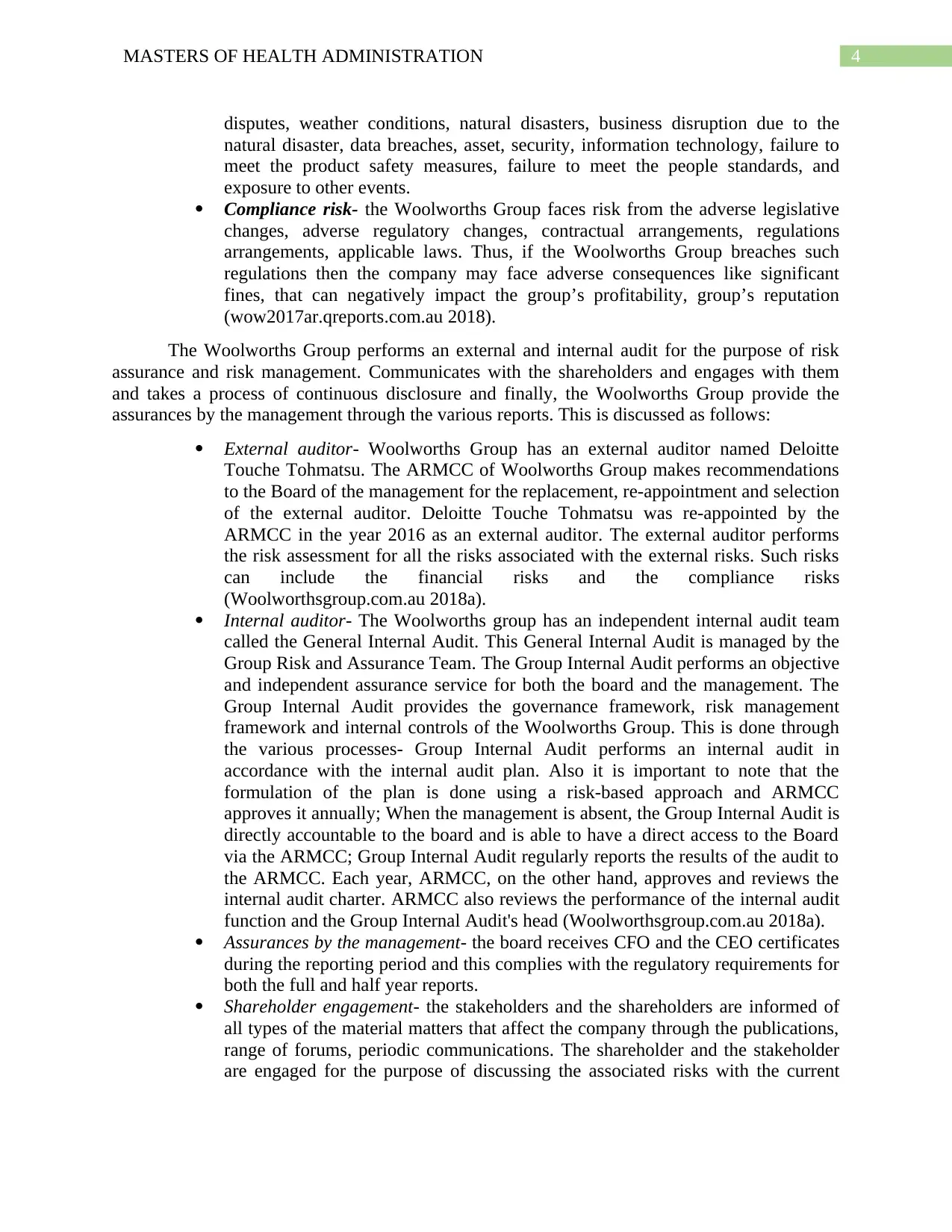
4MASTERS OF HEALTH ADMINISTRATION
disputes, weather conditions, natural disasters, business disruption due to the
natural disaster, data breaches, asset, security, information technology, failure to
meet the product safety measures, failure to meet the people standards, and
exposure to other events.
Compliance risk- the Woolworths Group faces risk from the adverse legislative
changes, adverse regulatory changes, contractual arrangements, regulations
arrangements, applicable laws. Thus, if the Woolworths Group breaches such
regulations then the company may face adverse consequences like significant
fines, that can negatively impact the group’s profitability, group’s reputation
(wow2017ar.qreports.com.au 2018).
The Woolworths Group performs an external and internal audit for the purpose of risk
assurance and risk management. Communicates with the shareholders and engages with them
and takes a process of continuous disclosure and finally, the Woolworths Group provide the
assurances by the management through the various reports. This is discussed as follows:
External auditor- Woolworths Group has an external auditor named Deloitte
Touche Tohmatsu. The ARMCC of Woolworths Group makes recommendations
to the Board of the management for the replacement, re-appointment and selection
of the external auditor. Deloitte Touche Tohmatsu was re-appointed by the
ARMCC in the year 2016 as an external auditor. The external auditor performs
the risk assessment for all the risks associated with the external risks. Such risks
can include the financial risks and the compliance risks
(Woolworthsgroup.com.au 2018a).
Internal auditor- The Woolworths group has an independent internal audit team
called the General Internal Audit. This General Internal Audit is managed by the
Group Risk and Assurance Team. The Group Internal Audit performs an objective
and independent assurance service for both the board and the management. The
Group Internal Audit provides the governance framework, risk management
framework and internal controls of the Woolworths Group. This is done through
the various processes- Group Internal Audit performs an internal audit in
accordance with the internal audit plan. Also it is important to note that the
formulation of the plan is done using a risk-based approach and ARMCC
approves it annually; When the management is absent, the Group Internal Audit is
directly accountable to the board and is able to have a direct access to the Board
via the ARMCC; Group Internal Audit regularly reports the results of the audit to
the ARMCC. Each year, ARMCC, on the other hand, approves and reviews the
internal audit charter. ARMCC also reviews the performance of the internal audit
function and the Group Internal Audit's head (Woolworthsgroup.com.au 2018a).
Assurances by the management- the board receives CFO and the CEO certificates
during the reporting period and this complies with the regulatory requirements for
both the full and half year reports.
Shareholder engagement- the stakeholders and the shareholders are informed of
all types of the material matters that affect the company through the publications,
range of forums, periodic communications. The shareholder and the stakeholder
are engaged for the purpose of discussing the associated risks with the current
disputes, weather conditions, natural disasters, business disruption due to the
natural disaster, data breaches, asset, security, information technology, failure to
meet the product safety measures, failure to meet the people standards, and
exposure to other events.
Compliance risk- the Woolworths Group faces risk from the adverse legislative
changes, adverse regulatory changes, contractual arrangements, regulations
arrangements, applicable laws. Thus, if the Woolworths Group breaches such
regulations then the company may face adverse consequences like significant
fines, that can negatively impact the group’s profitability, group’s reputation
(wow2017ar.qreports.com.au 2018).
The Woolworths Group performs an external and internal audit for the purpose of risk
assurance and risk management. Communicates with the shareholders and engages with them
and takes a process of continuous disclosure and finally, the Woolworths Group provide the
assurances by the management through the various reports. This is discussed as follows:
External auditor- Woolworths Group has an external auditor named Deloitte
Touche Tohmatsu. The ARMCC of Woolworths Group makes recommendations
to the Board of the management for the replacement, re-appointment and selection
of the external auditor. Deloitte Touche Tohmatsu was re-appointed by the
ARMCC in the year 2016 as an external auditor. The external auditor performs
the risk assessment for all the risks associated with the external risks. Such risks
can include the financial risks and the compliance risks
(Woolworthsgroup.com.au 2018a).
Internal auditor- The Woolworths group has an independent internal audit team
called the General Internal Audit. This General Internal Audit is managed by the
Group Risk and Assurance Team. The Group Internal Audit performs an objective
and independent assurance service for both the board and the management. The
Group Internal Audit provides the governance framework, risk management
framework and internal controls of the Woolworths Group. This is done through
the various processes- Group Internal Audit performs an internal audit in
accordance with the internal audit plan. Also it is important to note that the
formulation of the plan is done using a risk-based approach and ARMCC
approves it annually; When the management is absent, the Group Internal Audit is
directly accountable to the board and is able to have a direct access to the Board
via the ARMCC; Group Internal Audit regularly reports the results of the audit to
the ARMCC. Each year, ARMCC, on the other hand, approves and reviews the
internal audit charter. ARMCC also reviews the performance of the internal audit
function and the Group Internal Audit's head (Woolworthsgroup.com.au 2018a).
Assurances by the management- the board receives CFO and the CEO certificates
during the reporting period and this complies with the regulatory requirements for
both the full and half year reports.
Shareholder engagement- the stakeholders and the shareholders are informed of
all types of the material matters that affect the company through the publications,
range of forums, periodic communications. The shareholder and the stakeholder
are engaged for the purpose of discussing the associated risks with the current
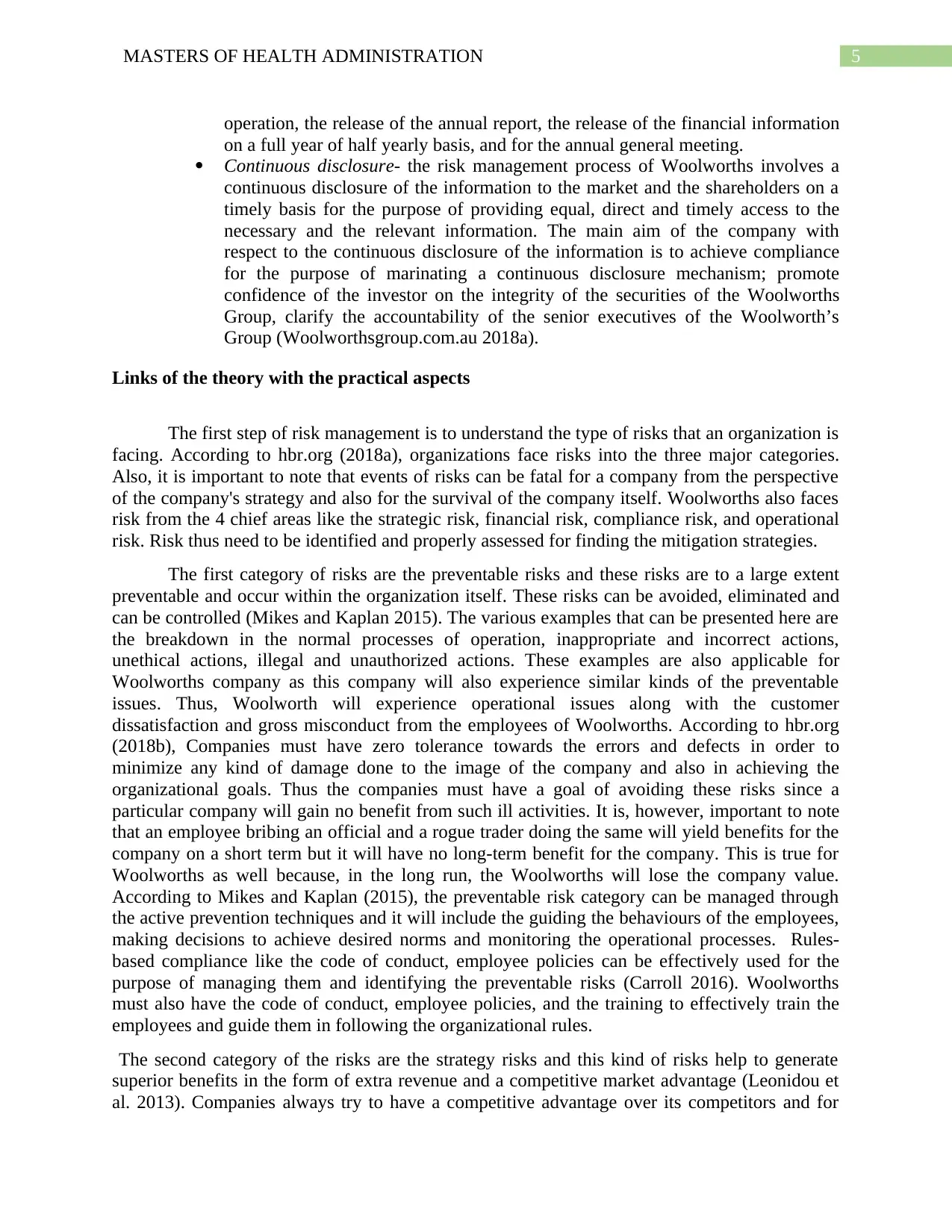
5MASTERS OF HEALTH ADMINISTRATION
operation, the release of the annual report, the release of the financial information
on a full year of half yearly basis, and for the annual general meeting.
Continuous disclosure- the risk management process of Woolworths involves a
continuous disclosure of the information to the market and the shareholders on a
timely basis for the purpose of providing equal, direct and timely access to the
necessary and the relevant information. The main aim of the company with
respect to the continuous disclosure of the information is to achieve compliance
for the purpose of marinating a continuous disclosure mechanism; promote
confidence of the investor on the integrity of the securities of the Woolworths
Group, clarify the accountability of the senior executives of the Woolworth’s
Group (Woolworthsgroup.com.au 2018a).
Links of the theory with the practical aspects
The first step of risk management is to understand the type of risks that an organization is
facing. According to hbr.org (2018a), organizations face risks into the three major categories.
Also, it is important to note that events of risks can be fatal for a company from the perspective
of the company's strategy and also for the survival of the company itself. Woolworths also faces
risk from the 4 chief areas like the strategic risk, financial risk, compliance risk, and operational
risk. Risk thus need to be identified and properly assessed for finding the mitigation strategies.
The first category of risks are the preventable risks and these risks are to a large extent
preventable and occur within the organization itself. These risks can be avoided, eliminated and
can be controlled (Mikes and Kaplan 2015). The various examples that can be presented here are
the breakdown in the normal processes of operation, inappropriate and incorrect actions,
unethical actions, illegal and unauthorized actions. These examples are also applicable for
Woolworths company as this company will also experience similar kinds of the preventable
issues. Thus, Woolworth will experience operational issues along with the customer
dissatisfaction and gross misconduct from the employees of Woolworths. According to hbr.org
(2018b), Companies must have zero tolerance towards the errors and defects in order to
minimize any kind of damage done to the image of the company and also in achieving the
organizational goals. Thus the companies must have a goal of avoiding these risks since a
particular company will gain no benefit from such ill activities. It is, however, important to note
that an employee bribing an official and a rogue trader doing the same will yield benefits for the
company on a short term but it will have no long-term benefit for the company. This is true for
Woolworths as well because, in the long run, the Woolworths will lose the company value.
According to Mikes and Kaplan (2015), the preventable risk category can be managed through
the active prevention techniques and it will include the guiding the behaviours of the employees,
making decisions to achieve desired norms and monitoring the operational processes. Rules-
based compliance like the code of conduct, employee policies can be effectively used for the
purpose of managing them and identifying the preventable risks (Carroll 2016). Woolworths
must also have the code of conduct, employee policies, and the training to effectively train the
employees and guide them in following the organizational rules.
The second category of the risks are the strategy risks and this kind of risks help to generate
superior benefits in the form of extra revenue and a competitive market advantage (Leonidou et
al. 2013). Companies always try to have a competitive advantage over its competitors and for
operation, the release of the annual report, the release of the financial information
on a full year of half yearly basis, and for the annual general meeting.
Continuous disclosure- the risk management process of Woolworths involves a
continuous disclosure of the information to the market and the shareholders on a
timely basis for the purpose of providing equal, direct and timely access to the
necessary and the relevant information. The main aim of the company with
respect to the continuous disclosure of the information is to achieve compliance
for the purpose of marinating a continuous disclosure mechanism; promote
confidence of the investor on the integrity of the securities of the Woolworths
Group, clarify the accountability of the senior executives of the Woolworth’s
Group (Woolworthsgroup.com.au 2018a).
Links of the theory with the practical aspects
The first step of risk management is to understand the type of risks that an organization is
facing. According to hbr.org (2018a), organizations face risks into the three major categories.
Also, it is important to note that events of risks can be fatal for a company from the perspective
of the company's strategy and also for the survival of the company itself. Woolworths also faces
risk from the 4 chief areas like the strategic risk, financial risk, compliance risk, and operational
risk. Risk thus need to be identified and properly assessed for finding the mitigation strategies.
The first category of risks are the preventable risks and these risks are to a large extent
preventable and occur within the organization itself. These risks can be avoided, eliminated and
can be controlled (Mikes and Kaplan 2015). The various examples that can be presented here are
the breakdown in the normal processes of operation, inappropriate and incorrect actions,
unethical actions, illegal and unauthorized actions. These examples are also applicable for
Woolworths company as this company will also experience similar kinds of the preventable
issues. Thus, Woolworth will experience operational issues along with the customer
dissatisfaction and gross misconduct from the employees of Woolworths. According to hbr.org
(2018b), Companies must have zero tolerance towards the errors and defects in order to
minimize any kind of damage done to the image of the company and also in achieving the
organizational goals. Thus the companies must have a goal of avoiding these risks since a
particular company will gain no benefit from such ill activities. It is, however, important to note
that an employee bribing an official and a rogue trader doing the same will yield benefits for the
company on a short term but it will have no long-term benefit for the company. This is true for
Woolworths as well because, in the long run, the Woolworths will lose the company value.
According to Mikes and Kaplan (2015), the preventable risk category can be managed through
the active prevention techniques and it will include the guiding the behaviours of the employees,
making decisions to achieve desired norms and monitoring the operational processes. Rules-
based compliance like the code of conduct, employee policies can be effectively used for the
purpose of managing them and identifying the preventable risks (Carroll 2016). Woolworths
must also have the code of conduct, employee policies, and the training to effectively train the
employees and guide them in following the organizational rules.
The second category of the risks are the strategy risks and this kind of risks help to generate
superior benefits in the form of extra revenue and a competitive market advantage (Leonidou et
al. 2013). Companies always try to have a competitive advantage over its competitors and for
⊘ This is a preview!⊘
Do you want full access?
Subscribe today to unlock all pages.

Trusted by 1+ million students worldwide
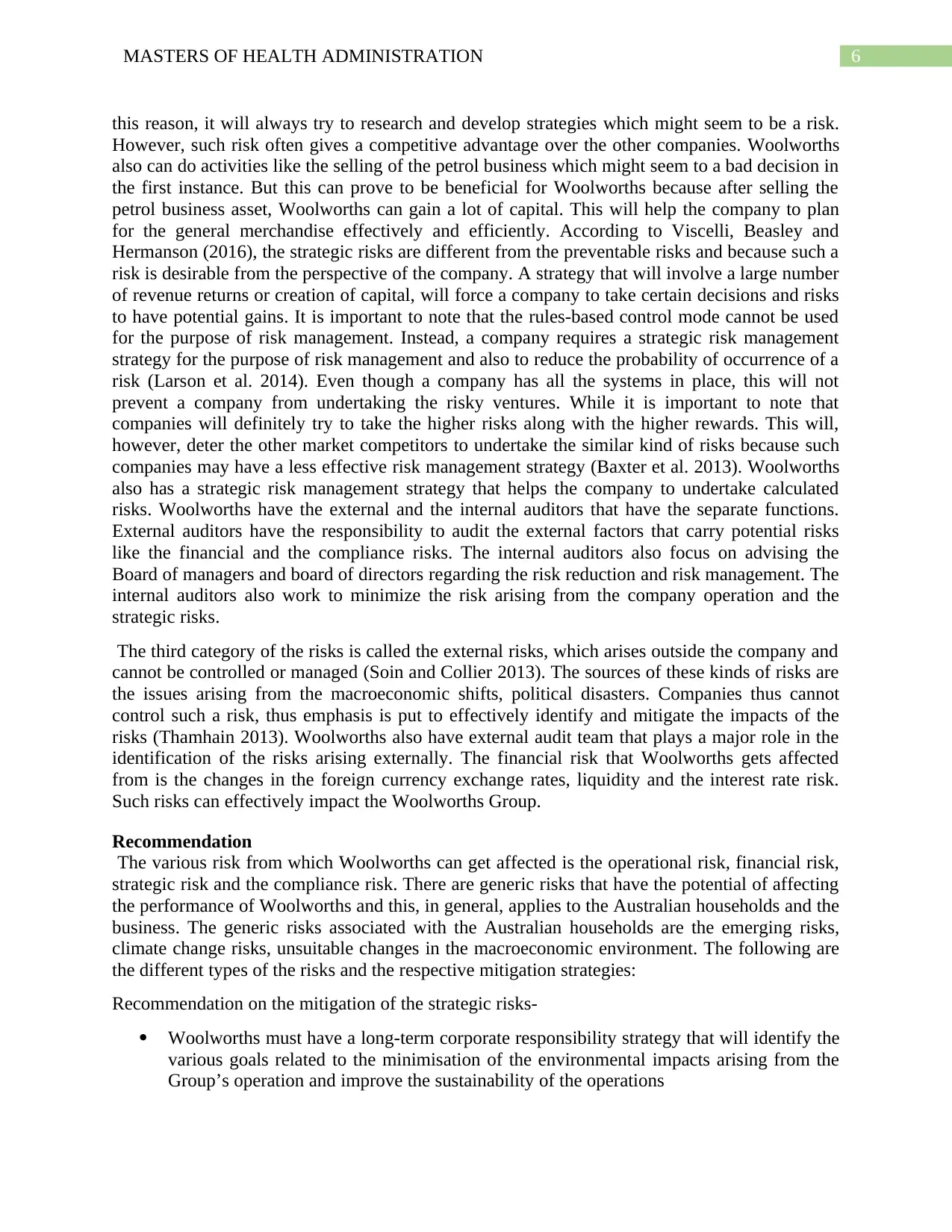
6MASTERS OF HEALTH ADMINISTRATION
this reason, it will always try to research and develop strategies which might seem to be a risk.
However, such risk often gives a competitive advantage over the other companies. Woolworths
also can do activities like the selling of the petrol business which might seem to a bad decision in
the first instance. But this can prove to be beneficial for Woolworths because after selling the
petrol business asset, Woolworths can gain a lot of capital. This will help the company to plan
for the general merchandise effectively and efficiently. According to Viscelli, Beasley and
Hermanson (2016), the strategic risks are different from the preventable risks and because such a
risk is desirable from the perspective of the company. A strategy that will involve a large number
of revenue returns or creation of capital, will force a company to take certain decisions and risks
to have potential gains. It is important to note that the rules-based control mode cannot be used
for the purpose of risk management. Instead, a company requires a strategic risk management
strategy for the purpose of risk management and also to reduce the probability of occurrence of a
risk (Larson et al. 2014). Even though a company has all the systems in place, this will not
prevent a company from undertaking the risky ventures. While it is important to note that
companies will definitely try to take the higher risks along with the higher rewards. This will,
however, deter the other market competitors to undertake the similar kind of risks because such
companies may have a less effective risk management strategy (Baxter et al. 2013). Woolworths
also has a strategic risk management strategy that helps the company to undertake calculated
risks. Woolworths have the external and the internal auditors that have the separate functions.
External auditors have the responsibility to audit the external factors that carry potential risks
like the financial and the compliance risks. The internal auditors also focus on advising the
Board of managers and board of directors regarding the risk reduction and risk management. The
internal auditors also work to minimize the risk arising from the company operation and the
strategic risks.
The third category of the risks is called the external risks, which arises outside the company and
cannot be controlled or managed (Soin and Collier 2013). The sources of these kinds of risks are
the issues arising from the macroeconomic shifts, political disasters. Companies thus cannot
control such a risk, thus emphasis is put to effectively identify and mitigate the impacts of the
risks (Thamhain 2013). Woolworths also have external audit team that plays a major role in the
identification of the risks arising externally. The financial risk that Woolworths gets affected
from is the changes in the foreign currency exchange rates, liquidity and the interest rate risk.
Such risks can effectively impact the Woolworths Group.
Recommendation
The various risk from which Woolworths can get affected is the operational risk, financial risk,
strategic risk and the compliance risk. There are generic risks that have the potential of affecting
the performance of Woolworths and this, in general, applies to the Australian households and the
business. The generic risks associated with the Australian households are the emerging risks,
climate change risks, unsuitable changes in the macroeconomic environment. The following are
the different types of the risks and the respective mitigation strategies:
Recommendation on the mitigation of the strategic risks-
Woolworths must have a long-term corporate responsibility strategy that will identify the
various goals related to the minimisation of the environmental impacts arising from the
Group’s operation and improve the sustainability of the operations
this reason, it will always try to research and develop strategies which might seem to be a risk.
However, such risk often gives a competitive advantage over the other companies. Woolworths
also can do activities like the selling of the petrol business which might seem to a bad decision in
the first instance. But this can prove to be beneficial for Woolworths because after selling the
petrol business asset, Woolworths can gain a lot of capital. This will help the company to plan
for the general merchandise effectively and efficiently. According to Viscelli, Beasley and
Hermanson (2016), the strategic risks are different from the preventable risks and because such a
risk is desirable from the perspective of the company. A strategy that will involve a large number
of revenue returns or creation of capital, will force a company to take certain decisions and risks
to have potential gains. It is important to note that the rules-based control mode cannot be used
for the purpose of risk management. Instead, a company requires a strategic risk management
strategy for the purpose of risk management and also to reduce the probability of occurrence of a
risk (Larson et al. 2014). Even though a company has all the systems in place, this will not
prevent a company from undertaking the risky ventures. While it is important to note that
companies will definitely try to take the higher risks along with the higher rewards. This will,
however, deter the other market competitors to undertake the similar kind of risks because such
companies may have a less effective risk management strategy (Baxter et al. 2013). Woolworths
also has a strategic risk management strategy that helps the company to undertake calculated
risks. Woolworths have the external and the internal auditors that have the separate functions.
External auditors have the responsibility to audit the external factors that carry potential risks
like the financial and the compliance risks. The internal auditors also focus on advising the
Board of managers and board of directors regarding the risk reduction and risk management. The
internal auditors also work to minimize the risk arising from the company operation and the
strategic risks.
The third category of the risks is called the external risks, which arises outside the company and
cannot be controlled or managed (Soin and Collier 2013). The sources of these kinds of risks are
the issues arising from the macroeconomic shifts, political disasters. Companies thus cannot
control such a risk, thus emphasis is put to effectively identify and mitigate the impacts of the
risks (Thamhain 2013). Woolworths also have external audit team that plays a major role in the
identification of the risks arising externally. The financial risk that Woolworths gets affected
from is the changes in the foreign currency exchange rates, liquidity and the interest rate risk.
Such risks can effectively impact the Woolworths Group.
Recommendation
The various risk from which Woolworths can get affected is the operational risk, financial risk,
strategic risk and the compliance risk. There are generic risks that have the potential of affecting
the performance of Woolworths and this, in general, applies to the Australian households and the
business. The generic risks associated with the Australian households are the emerging risks,
climate change risks, unsuitable changes in the macroeconomic environment. The following are
the different types of the risks and the respective mitigation strategies:
Recommendation on the mitigation of the strategic risks-
Woolworths must have a long-term corporate responsibility strategy that will identify the
various goals related to the minimisation of the environmental impacts arising from the
Group’s operation and improve the sustainability of the operations
Paraphrase This Document
Need a fresh take? Get an instant paraphrase of this document with our AI Paraphraser
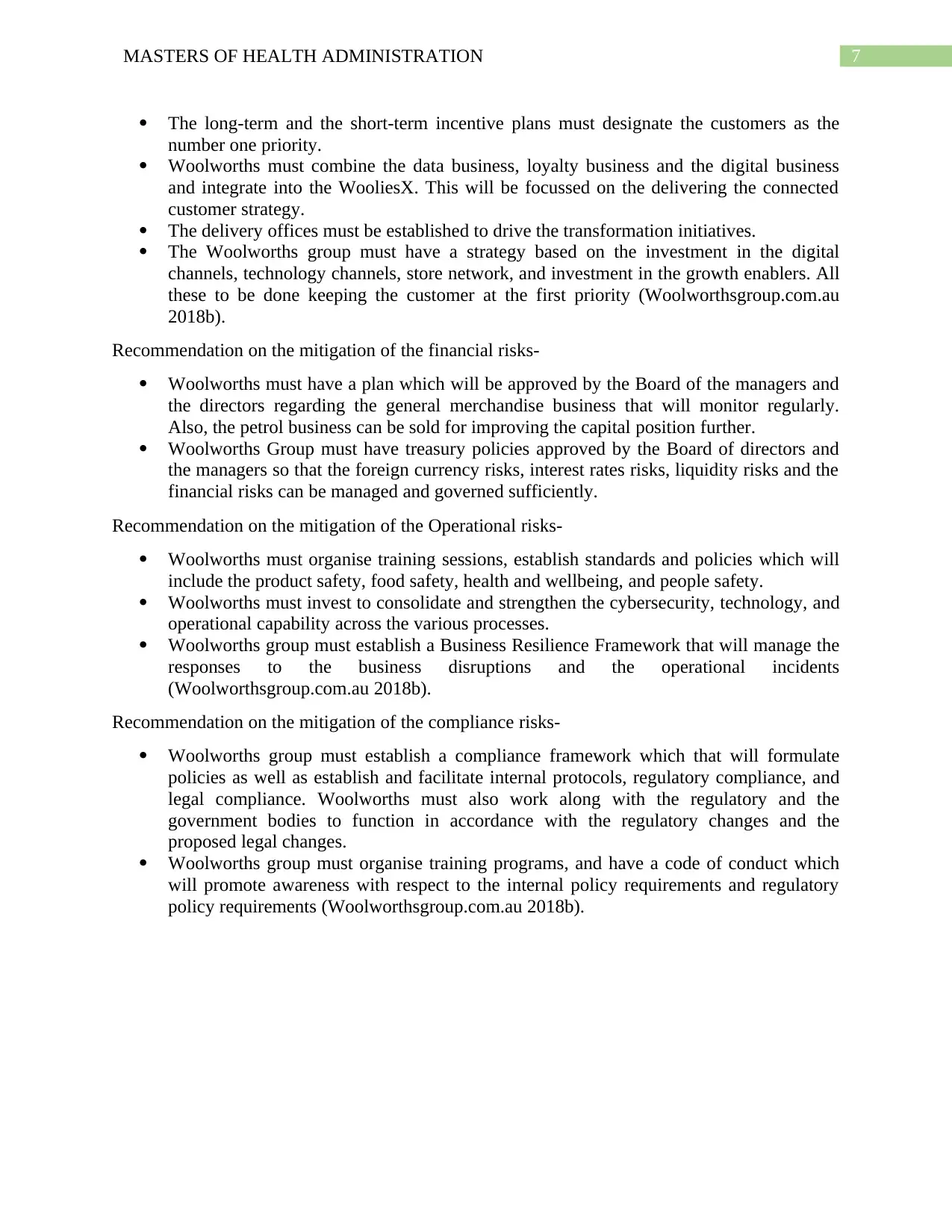
7MASTERS OF HEALTH ADMINISTRATION
The long-term and the short-term incentive plans must designate the customers as the
number one priority.
Woolworths must combine the data business, loyalty business and the digital business
and integrate into the WooliesX. This will be focussed on the delivering the connected
customer strategy.
The delivery offices must be established to drive the transformation initiatives.
The Woolworths group must have a strategy based on the investment in the digital
channels, technology channels, store network, and investment in the growth enablers. All
these to be done keeping the customer at the first priority (Woolworthsgroup.com.au
2018b).
Recommendation on the mitigation of the financial risks-
Woolworths must have a plan which will be approved by the Board of the managers and
the directors regarding the general merchandise business that will monitor regularly.
Also, the petrol business can be sold for improving the capital position further.
Woolworths Group must have treasury policies approved by the Board of directors and
the managers so that the foreign currency risks, interest rates risks, liquidity risks and the
financial risks can be managed and governed sufficiently.
Recommendation on the mitigation of the Operational risks-
Woolworths must organise training sessions, establish standards and policies which will
include the product safety, food safety, health and wellbeing, and people safety.
Woolworths must invest to consolidate and strengthen the cybersecurity, technology, and
operational capability across the various processes.
Woolworths group must establish a Business Resilience Framework that will manage the
responses to the business disruptions and the operational incidents
(Woolworthsgroup.com.au 2018b).
Recommendation on the mitigation of the compliance risks-
Woolworths group must establish a compliance framework which that will formulate
policies as well as establish and facilitate internal protocols, regulatory compliance, and
legal compliance. Woolworths must also work along with the regulatory and the
government bodies to function in accordance with the regulatory changes and the
proposed legal changes.
Woolworths group must organise training programs, and have a code of conduct which
will promote awareness with respect to the internal policy requirements and regulatory
policy requirements (Woolworthsgroup.com.au 2018b).
The long-term and the short-term incentive plans must designate the customers as the
number one priority.
Woolworths must combine the data business, loyalty business and the digital business
and integrate into the WooliesX. This will be focussed on the delivering the connected
customer strategy.
The delivery offices must be established to drive the transformation initiatives.
The Woolworths group must have a strategy based on the investment in the digital
channels, technology channels, store network, and investment in the growth enablers. All
these to be done keeping the customer at the first priority (Woolworthsgroup.com.au
2018b).
Recommendation on the mitigation of the financial risks-
Woolworths must have a plan which will be approved by the Board of the managers and
the directors regarding the general merchandise business that will monitor regularly.
Also, the petrol business can be sold for improving the capital position further.
Woolworths Group must have treasury policies approved by the Board of directors and
the managers so that the foreign currency risks, interest rates risks, liquidity risks and the
financial risks can be managed and governed sufficiently.
Recommendation on the mitigation of the Operational risks-
Woolworths must organise training sessions, establish standards and policies which will
include the product safety, food safety, health and wellbeing, and people safety.
Woolworths must invest to consolidate and strengthen the cybersecurity, technology, and
operational capability across the various processes.
Woolworths group must establish a Business Resilience Framework that will manage the
responses to the business disruptions and the operational incidents
(Woolworthsgroup.com.au 2018b).
Recommendation on the mitigation of the compliance risks-
Woolworths group must establish a compliance framework which that will formulate
policies as well as establish and facilitate internal protocols, regulatory compliance, and
legal compliance. Woolworths must also work along with the regulatory and the
government bodies to function in accordance with the regulatory changes and the
proposed legal changes.
Woolworths group must organise training programs, and have a code of conduct which
will promote awareness with respect to the internal policy requirements and regulatory
policy requirements (Woolworthsgroup.com.au 2018b).
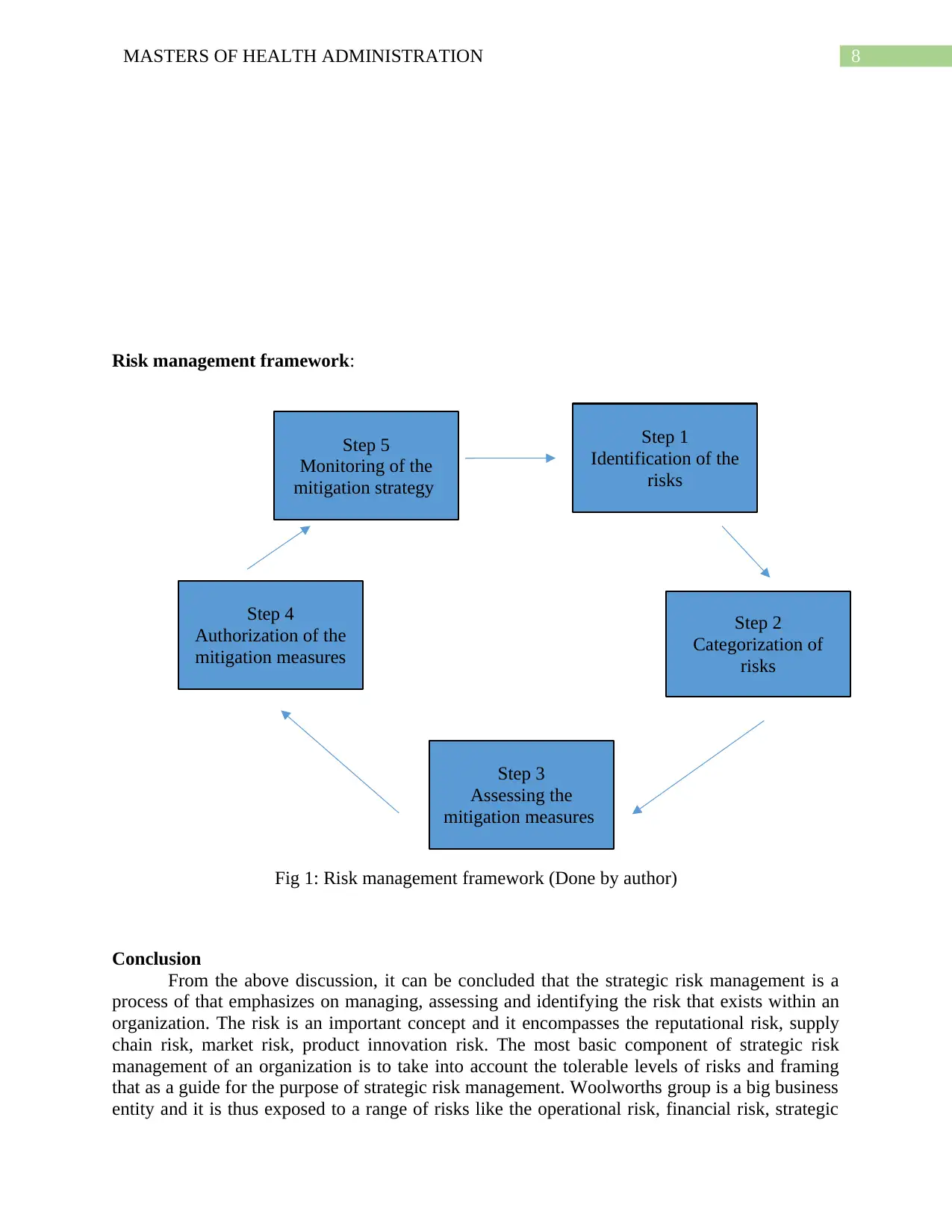
8MASTERS OF HEALTH ADMINISTRATION
Step 1
Identification of the
risks
Step 2
Categorization of
risks
Step 3
Assessing the
mitigation measures
Step 4
Authorization of the
mitigation measures
Step 5
Monitoring of the
mitigation strategy
Risk management framework:
Fig 1: Risk management framework (Done by author)
Conclusion
From the above discussion, it can be concluded that the strategic risk management is a
process of that emphasizes on managing, assessing and identifying the risk that exists within an
organization. The risk is an important concept and it encompasses the reputational risk, supply
chain risk, market risk, product innovation risk. The most basic component of strategic risk
management of an organization is to take into account the tolerable levels of risks and framing
that as a guide for the purpose of strategic risk management. Woolworths group is a big business
entity and it is thus exposed to a range of risks like the operational risk, financial risk, strategic
Step 1
Identification of the
risks
Step 2
Categorization of
risks
Step 3
Assessing the
mitigation measures
Step 4
Authorization of the
mitigation measures
Step 5
Monitoring of the
mitigation strategy
Risk management framework:
Fig 1: Risk management framework (Done by author)
Conclusion
From the above discussion, it can be concluded that the strategic risk management is a
process of that emphasizes on managing, assessing and identifying the risk that exists within an
organization. The risk is an important concept and it encompasses the reputational risk, supply
chain risk, market risk, product innovation risk. The most basic component of strategic risk
management of an organization is to take into account the tolerable levels of risks and framing
that as a guide for the purpose of strategic risk management. Woolworths group is a big business
entity and it is thus exposed to a range of risks like the operational risk, financial risk, strategic
⊘ This is a preview!⊘
Do you want full access?
Subscribe today to unlock all pages.

Trusted by 1+ million students worldwide
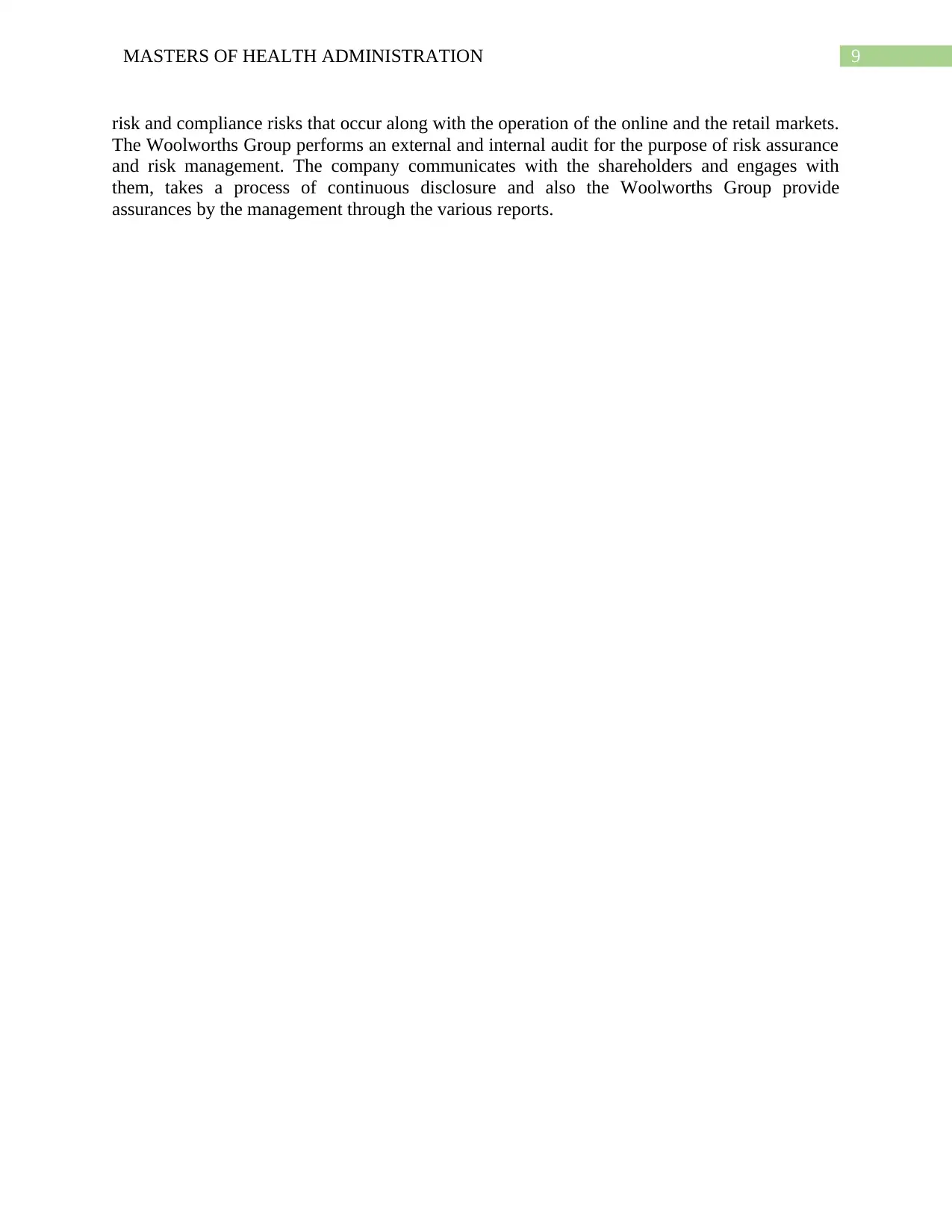
9MASTERS OF HEALTH ADMINISTRATION
risk and compliance risks that occur along with the operation of the online and the retail markets.
The Woolworths Group performs an external and internal audit for the purpose of risk assurance
and risk management. The company communicates with the shareholders and engages with
them, takes a process of continuous disclosure and also the Woolworths Group provide
assurances by the management through the various reports.
risk and compliance risks that occur along with the operation of the online and the retail markets.
The Woolworths Group performs an external and internal audit for the purpose of risk assurance
and risk management. The company communicates with the shareholders and engages with
them, takes a process of continuous disclosure and also the Woolworths Group provide
assurances by the management through the various reports.
Paraphrase This Document
Need a fresh take? Get an instant paraphrase of this document with our AI Paraphraser
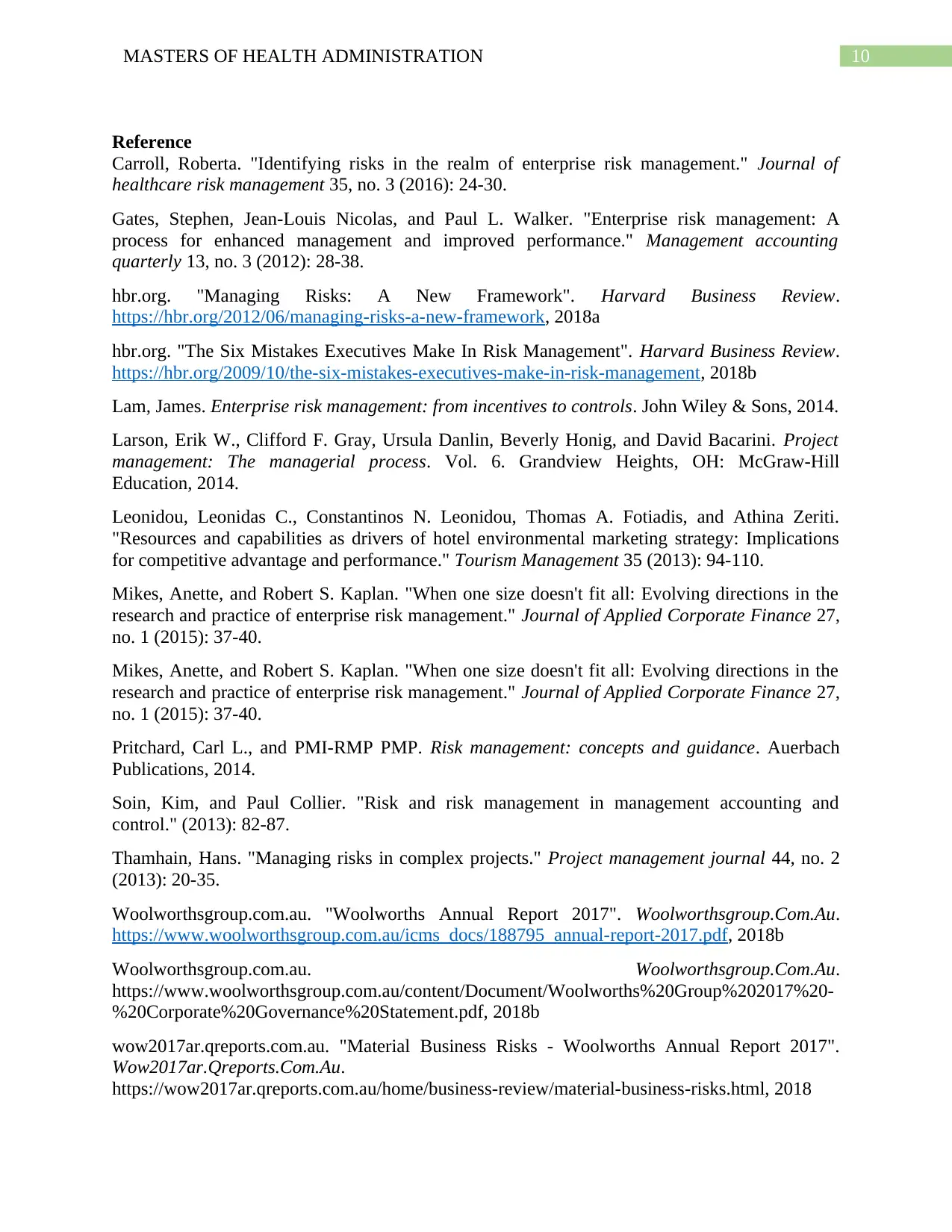
10MASTERS OF HEALTH ADMINISTRATION
Reference
Carroll, Roberta. "Identifying risks in the realm of enterprise risk management." Journal of
healthcare risk management 35, no. 3 (2016): 24-30.
Gates, Stephen, Jean-Louis Nicolas, and Paul L. Walker. "Enterprise risk management: A
process for enhanced management and improved performance." Management accounting
quarterly 13, no. 3 (2012): 28-38.
hbr.org. "Managing Risks: A New Framework". Harvard Business Review.
https://hbr.org/2012/06/managing-risks-a-new-framework, 2018a
hbr.org. "The Six Mistakes Executives Make In Risk Management". Harvard Business Review.
https://hbr.org/2009/10/the-six-mistakes-executives-make-in-risk-management, 2018b
Lam, James. Enterprise risk management: from incentives to controls. John Wiley & Sons, 2014.
Larson, Erik W., Clifford F. Gray, Ursula Danlin, Beverly Honig, and David Bacarini. Project
management: The managerial process. Vol. 6. Grandview Heights, OH: McGraw-Hill
Education, 2014.
Leonidou, Leonidas C., Constantinos N. Leonidou, Thomas A. Fotiadis, and Athina Zeriti.
"Resources and capabilities as drivers of hotel environmental marketing strategy: Implications
for competitive advantage and performance." Tourism Management 35 (2013): 94-110.
Mikes, Anette, and Robert S. Kaplan. "When one size doesn't fit all: Evolving directions in the
research and practice of enterprise risk management." Journal of Applied Corporate Finance 27,
no. 1 (2015): 37-40.
Mikes, Anette, and Robert S. Kaplan. "When one size doesn't fit all: Evolving directions in the
research and practice of enterprise risk management." Journal of Applied Corporate Finance 27,
no. 1 (2015): 37-40.
Pritchard, Carl L., and PMI-RMP PMP. Risk management: concepts and guidance. Auerbach
Publications, 2014.
Soin, Kim, and Paul Collier. "Risk and risk management in management accounting and
control." (2013): 82-87.
Thamhain, Hans. "Managing risks in complex projects." Project management journal 44, no. 2
(2013): 20-35.
Woolworthsgroup.com.au. "Woolworths Annual Report 2017". Woolworthsgroup.Com.Au.
https://www.woolworthsgroup.com.au/icms_docs/188795_annual-report-2017.pdf, 2018b
Woolworthsgroup.com.au. Woolworthsgroup.Com.Au.
https://www.woolworthsgroup.com.au/content/Document/Woolworths%20Group%202017%20-
%20Corporate%20Governance%20Statement.pdf, 2018b
wow2017ar.qreports.com.au. "Material Business Risks - Woolworths Annual Report 2017".
Wow2017ar.Qreports.Com.Au.
https://wow2017ar.qreports.com.au/home/business-review/material-business-risks.html, 2018
Reference
Carroll, Roberta. "Identifying risks in the realm of enterprise risk management." Journal of
healthcare risk management 35, no. 3 (2016): 24-30.
Gates, Stephen, Jean-Louis Nicolas, and Paul L. Walker. "Enterprise risk management: A
process for enhanced management and improved performance." Management accounting
quarterly 13, no. 3 (2012): 28-38.
hbr.org. "Managing Risks: A New Framework". Harvard Business Review.
https://hbr.org/2012/06/managing-risks-a-new-framework, 2018a
hbr.org. "The Six Mistakes Executives Make In Risk Management". Harvard Business Review.
https://hbr.org/2009/10/the-six-mistakes-executives-make-in-risk-management, 2018b
Lam, James. Enterprise risk management: from incentives to controls. John Wiley & Sons, 2014.
Larson, Erik W., Clifford F. Gray, Ursula Danlin, Beverly Honig, and David Bacarini. Project
management: The managerial process. Vol. 6. Grandview Heights, OH: McGraw-Hill
Education, 2014.
Leonidou, Leonidas C., Constantinos N. Leonidou, Thomas A. Fotiadis, and Athina Zeriti.
"Resources and capabilities as drivers of hotel environmental marketing strategy: Implications
for competitive advantage and performance." Tourism Management 35 (2013): 94-110.
Mikes, Anette, and Robert S. Kaplan. "When one size doesn't fit all: Evolving directions in the
research and practice of enterprise risk management." Journal of Applied Corporate Finance 27,
no. 1 (2015): 37-40.
Mikes, Anette, and Robert S. Kaplan. "When one size doesn't fit all: Evolving directions in the
research and practice of enterprise risk management." Journal of Applied Corporate Finance 27,
no. 1 (2015): 37-40.
Pritchard, Carl L., and PMI-RMP PMP. Risk management: concepts and guidance. Auerbach
Publications, 2014.
Soin, Kim, and Paul Collier. "Risk and risk management in management accounting and
control." (2013): 82-87.
Thamhain, Hans. "Managing risks in complex projects." Project management journal 44, no. 2
(2013): 20-35.
Woolworthsgroup.com.au. "Woolworths Annual Report 2017". Woolworthsgroup.Com.Au.
https://www.woolworthsgroup.com.au/icms_docs/188795_annual-report-2017.pdf, 2018b
Woolworthsgroup.com.au. Woolworthsgroup.Com.Au.
https://www.woolworthsgroup.com.au/content/Document/Woolworths%20Group%202017%20-
%20Corporate%20Governance%20Statement.pdf, 2018b
wow2017ar.qreports.com.au. "Material Business Risks - Woolworths Annual Report 2017".
Wow2017ar.Qreports.Com.Au.
https://wow2017ar.qreports.com.au/home/business-review/material-business-risks.html, 2018
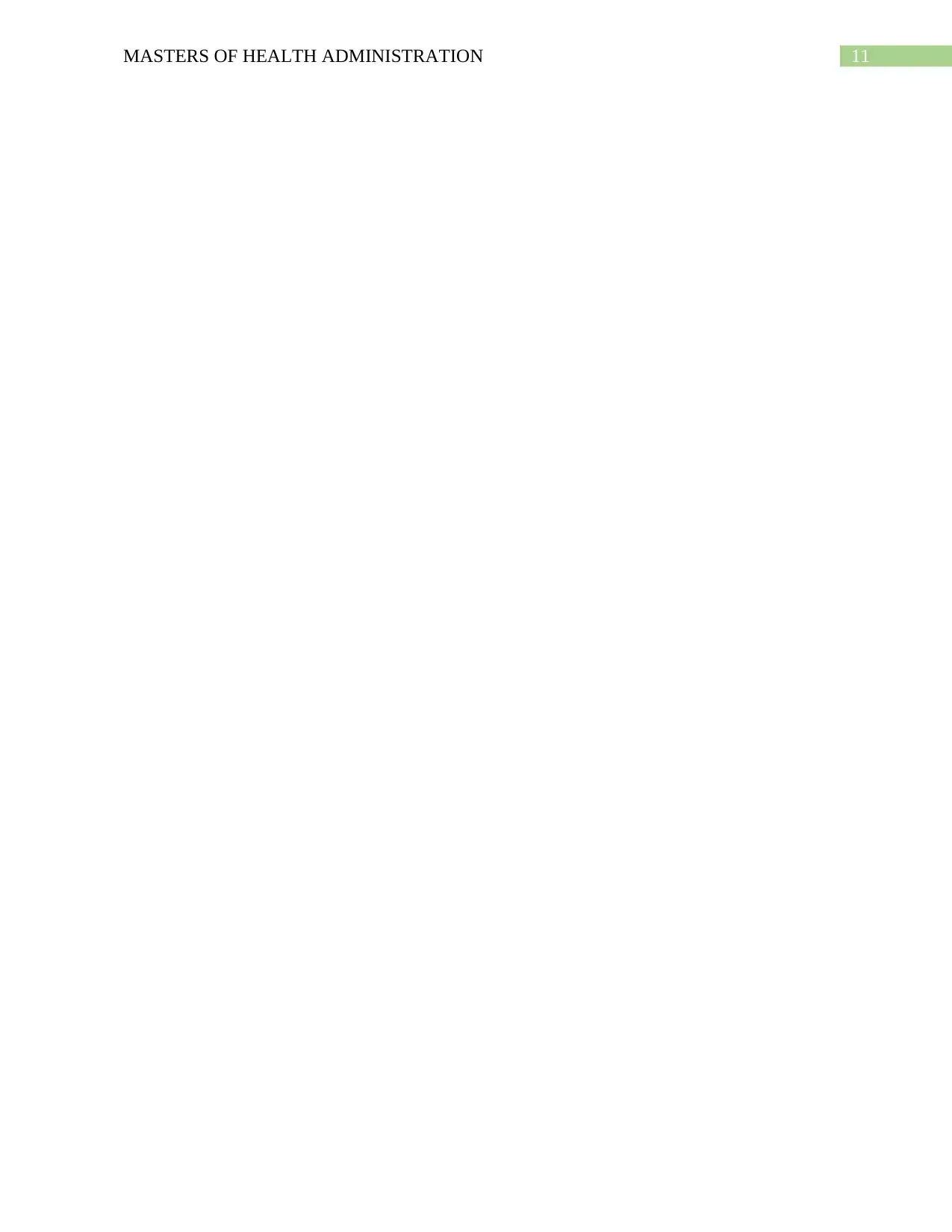
11MASTERS OF HEALTH ADMINISTRATION
⊘ This is a preview!⊘
Do you want full access?
Subscribe today to unlock all pages.

Trusted by 1+ million students worldwide
1 out of 12
Related Documents
Your All-in-One AI-Powered Toolkit for Academic Success.
+13062052269
info@desklib.com
Available 24*7 on WhatsApp / Email
![[object Object]](/_next/static/media/star-bottom.7253800d.svg)
Unlock your academic potential
Copyright © 2020–2025 A2Z Services. All Rights Reserved. Developed and managed by ZUCOL.




